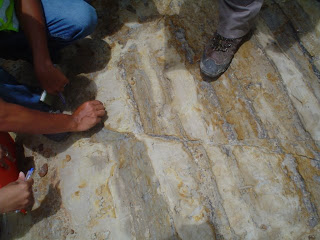In Bintulu, we visited several Outcrops. Among them were the Tatau, Nyalau and Liang Formations, formed during the Paleocene, Pliocene and Miocene times.
What are outcrops, you may ask. Well, outcrops are uplifted structures, cut through by road builders. Just imagine a piece of layered cake. From the surface, you may think that it's brown throughout. But when you cut through it, you will see several colourful layers, thin layers, thick layers, all of different colours and composition. The earth is just like that as well. It does not contain sediments from a single period, nor single composition. It consists of several grains of different sizes and organic matter.Varying depositional environment will form different patterns in the outcrop when one cuts through it.
On the first day itself, I learnt how to identify the amount of organic matter present in any lithology. The blacker or darker it is, the higher the amount of organic matter. If we have white sand, means we don't have organisms living here. If we have very black sand, this indicates that there were lots of organic matter living here last time. This can be proved by the presence of burrows, forams, shells, fossilized crabs, etc. However, that may not be necessarily true all the time. Sometimes, the sand can be very black as well if it is coated with manganese.
So, if we 're looking for source rocks, we don't go looking for rivers upstream, where it's highly oxidized and the water is very clear. Source rocks are usually present downstream, where there's less energy, all the grains get to settle down, the water is calm, and there's potential for the survival of organic matter.
A stream is also divided into upstream and downstream. Grains from an upstream river are angular because they have been 'sharpened' by the high energy flow. Besides that, the grains are very coarse, and may even be classified as boulders. No specific arrangement for the grains upstream can be observed because the flow is rather turbulent. This leaves the grain no time to settle down. Before they even start resting at the bottom of the river bed, they are pushed hard and strong by the energy of the gushing waters. Downstream of a river, the sand grains are rounder, smaller and settle down in the river bed in a nice layer. Thin or thick, that depends on the water level, and surrounding environment.
 Looking at the ripples, one can also determine the flow direction
Looking at the ripples, one can also determine the flow direction
So, how do we recognize whether these compacted sands or rock bodies are from the river, sea, beach or swamps? Besides looking at the grain size and the sorting arrangement, we also look at the fossils and composition present. It is quite often you will have stunning findings.

For instance, we saw roots burried in the formation in the miocene times... or clay that were formed during the pliocene times. Just imagine that. A storm came, a river passed through the region, an earthquake occured and the whole forest were burried under tonnes and tonnes of sands overnight. Wow.... I'm awed.
 Black, Shiny Coal
Black, Shiny Coal
After a long, long time, once these roots are burried under high pressure and high temperature, compacted by the hydrostatic pressure and the lithostatic pressure, these roots from millions and millions of trees become coal.
 (Top View): You see these little grey marks on the rocks? They're burrows made by crabs!
(Top View): You see these little grey marks on the rocks? They're burrows made by crabs!Sometimes, we also spot burrows which used to be houses for the little crabs. In some of these burrows, the pellets are still very well preserved even after millions and millions of years!
 (cross sectional view): These are burrows in the rocks
(cross sectional view): These are burrows in the rocks
 At one of our stops, we saw a 'hole' in the sky made by the fluffy white clouds.
At one of our stops, we saw a 'hole' in the sky made by the fluffy white clouds.~~~~~~~~~~~~~~~~~~~~~~~~~~~~~~~~~~~~~~~~~~~~~~~~~~~~~~~~~~~~~~~~
Extra Notes about Sandstone:
Hieratus is a period of non-deposition. Another name for unconformity.
Pyrite or gold is formed under reduced oxygen environment. It is a product of the reaction between iron and sulfur. That is why in Sarawak, we have low H2S content. Under high sulfur conditions, iron reacts with sulfur to form pyrite.
Carbonates, on the other hand, contain high H2S. None of the minerals present are able to bond with Sulphur to form another mineral. Thus, sulphur content in carbonate rocks are often very high.
~~~~~~~~~~~~~~~~~~~~~~~~~~~~~~~~~~~~~~~~~~~~~~~~~~~~~~~~~~~~~~~~








































